~ 17 ~
~ The Study of Threes ~
http://threesology.org
Researchers as of 8/29/2019
| Devil's Advocate Series: | ||||||||
|---|---|---|---|---|---|---|---|---|
| 1 | 2 | 3 | 4 | 5 | 6 | 7 | 8 | 9 |
| 10 | 11 | 12 | 13 | 14A 14B |
15 | 16 | 17 | 18 |
| 19 | 20 | 21 | 22A 22B |
23 | 24 | 25 | 26 | 27 |
| 28 | 29 | 30 A | 30 B | 31 | 32 | 33a | 33b | 33c |
| 34 | 35 | 36 | 37 | 38 | 39 | 40 | 41 A | 41 B |
As alluded to on the previous page, the "three" may be a consolidation of three separate events, or a one event plus a secondary event; whereby altogether they are unconsciously being counted as a three. A simple example of this is the movement of the Sun and its changing effects during the day, such that we humans have come to describe three particular ones labeled as dawn, noon, and dusk. However, there are other pattern=of-three references correlated with the movements of the Sun (actually, the spinning of the Earth), such as "before noon, noon, after-noon", "morning, noon, night", "breakfast, lunch/dinner, supper", "dawn, midday, dusk"; "father, son, holy spirit", "Horus (morning) - Ra (noon) - Atum (dusk)" (3 ancient Egyptian gods for solar "phases"), "infancy, adult hood, old age", "birth, living, death" (from which comes the notion of re-birth), etc...
Since it is recognizable that humans are inclined towards condensation and abbreviation, this may be an act of conservation... a means to conserve mental energy... for example. Hence my role as a Devil's Advocate in this series is one in which I am disinclining myself to readily accept the many three-patterned expressions as an actual "three", whatever we might otherwise describe our observations denoted as a "three" (directly or indirectly). Nor am I to be so inclined to count the numerous three-patterned examples off the top of my head as being representative as the most abundant pattern of usage by humanity. Since there are multiple other patterns and I have not made as strenuous an attempt to make collections of other patterns, it stands to reason that any insistence or pronouncement that the "three" is the most abundant is premature without definitive evidence. Since I have encountered numerous other patterns standing apart from and together in conjunction with various encounters of the "three", an attempt to devise a philosophy involving the "three" must necessarily include these other patterns as part of the overall defining character, including the absence of the three as well as other patterns.
There are a 'number' of criteria one might chose to use in how the collect and describe a given singular pattern and multiple patterns. While it is quite easy to lump multiple examples together with the usage of a general counting scheme, individuation of details may well cause us to either re-think the criteria we are using, or devise some measure of rationalization to discount what we might otherwise describe as a poor fit to a given theme of distinction. If I attempt to list all expressions of a "three" pattern based on some generalized count, it is quite easy to lump different subject materials into one large mass of examples. However, if I become inclined to isolate the mass into different subject materials, this can cause one to stand guard over the separations as a sentinel... to safe-guard a particular formula of dissection. For example, when we encounter the idea of the Trifunctional hypothesis (primarily associated with the French mythographer Georges Dumézil, his view of there being a "pattern of three" related to Indo-European cultures was in the form of a tripartite functionality related to three social divisions.
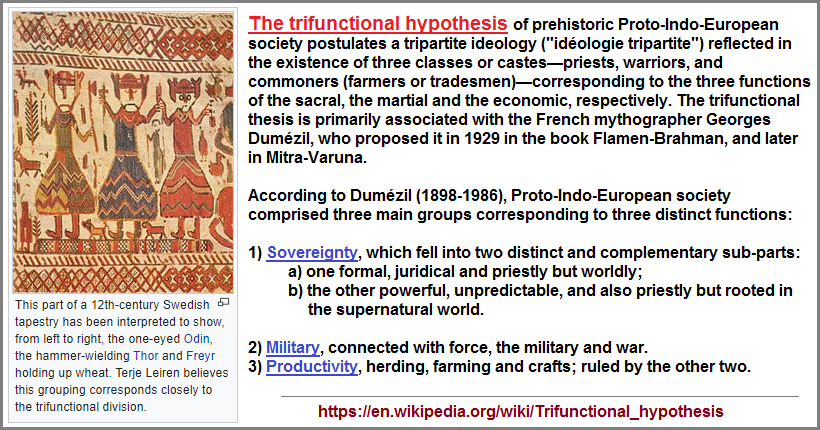
Whether or not Dumezil ever thought about how extensive the "three" existed in other subjects, is unknown to me. Whereas he did make a lot of comparisons based on a small criteria of functions, the fact still remains is that the overall pattern of his is idea is a three. We can compare this to other ideas based on a simple and generalized count of his portrayal of Indo-European cultures. Unfortunately, his (and others') obsession with the "three" led them to discount the presence of a 4th social caste such as the peasants or Shudra. In any respect, at least one detractor (as cited in the Wikipedia article) considers Dumezil's tripartite idea may be based more on an artefact of personalized selectivity than as a realistic organizing principle of existing social qualities. And yet, this argument misses the point about the usage of a "three" as a recurrence of overall human orientation that can be found in other subjects as well. Regardless if one believes in the Dumezillian hypothesis or not, the fact remains he used a pattern-of-three idea which others took seriously enough to accept or argue against. It is the same state of affairs one might apply to the three levels of class in the Middle ages:
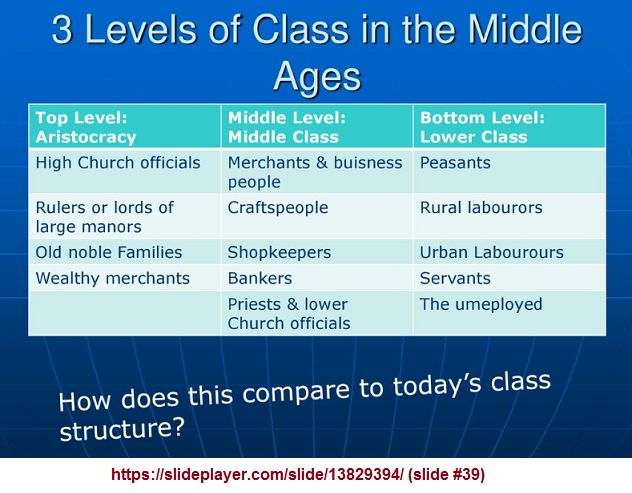
And to the foregoing let us add three often distinguished middle age periods, though on many accounts there is said to be not clear distinctions of beginning and end since the periods overlap and otherwise transition from one to another period. Nonetheless, a pattern-of-three orientation is used, whether you describe it as a convenient generality for discussion of selectively chosen different events or not. We do not see the same mental exercise of humans in different subjects relying on the repetition of some other numerically identifiable pattern such as two, four, five, six, seven, etc... though we can find examples of these if we strive to search for them in isolated contexts. The usage of the "three-pattern" is applied in obscured, subtle, and obvious ways. In other words, viewing the different numbers as if they were animal or organism species, the "three" appears to be more of an omnivorous eater than other number-relateable patterns... though others have a multi-subject diet as well.
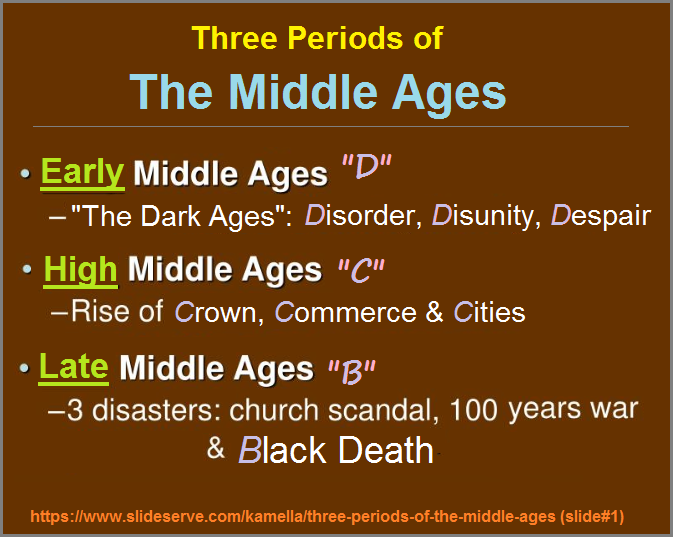
Does the usage of one three-pattern in a subject lead to the adoption of this pattern for other consideration both in and out of the same subject? Are people simply mimicking one another? Then why not mimic the two, four, five, six, etc., with the same frequency as we see the three? And in citing different patterns such as the two and four or five and six, we find they are closely tied to the "three", or vice-versa, but we don't see larger number values being used as models of inquiry, interpretation, or explanation?
If someone were to say they eat three meals a day, another might say they eat two and another might say they eat one, while those who snack every time they get a chance may not say anything, for fear of some level of imagined social condemnation from themselves or another. While one-upmanships do occur in terms of describing greater quantities, there are limitations to how much one may describe; which may involve using a pattern-of-three expression such as "A whole lot", "A whole bunch", "not too much", "not too many" etc... While the same expressions may have more or less words attached to them in different cultures, there nonetheless exists a small quantity... and this usage of small quantities by the human mind is part of the "Threesological" approach for cataloging cognitive patterns. The recognition of multiple "three" patterns is just a preliminary means of introducing oneself and others to a larger assortment of patterns being used, but that the assortment is small and this "small" is related to the primitive notion of "many", which was by some accounts the third quantity of identifying quantitative values beyond the "two" or recurring presence of "pairing" we find in ideas concerning developmental biology as well as the referencing of planetary arrangements such as binary star systems.
As a further reference to the 3-in-1 (or 3-from-1) pattern seen in the Sun with its "three moments" or phases (dawn- noon- dusk), let us muse upon whether this billions of years old event has somehow acted like a branding iron on the impressionable building blocks of life to cause the existence of a three-patterned "brand" to occur on the "hide" of developmental processes, extending all the way "up" to the development of the human psyche as described by Sigmund Freud:

And though one might want to argue that this is an artifact of the human mind just as is the Trifunctional Hypothesis of Georges' Dumezil has been suggested as being, we nonetheless encounter another usage of a pattern-of-three. In this same vein of describing the mind we could add a three-patterned idea concerning the development of the brain which provides for the presumed existence of three functionalized compartments denoted as the Triune Brain concept developed by Paul D. MacLean, though it is said the idea is discredited: A theory abandoned but still compelling by Peter Farley— which offers the view that MacLean's view of the developing brain is wrong (in Evolutionary terms), but failed to address the usage of a "three" as a recurring cognitive construct... whether these constructs are real, imagined, fact, or fiction. The article in fact does not discuss the evolution of human cognition and is reminiscent of a case where the forest is not recognized because one is blinded by the presence of so many trees (and not "threes"), and has lived so long in the deep forest of a given subject, they can not recognize the presence of individual trees except for those one makes person usage of... like so many animals in different contexts (to eat, sleep in/on, gnaw at, scratch at, urinate on, take lumber from, take fruit from, transplant, etc...).
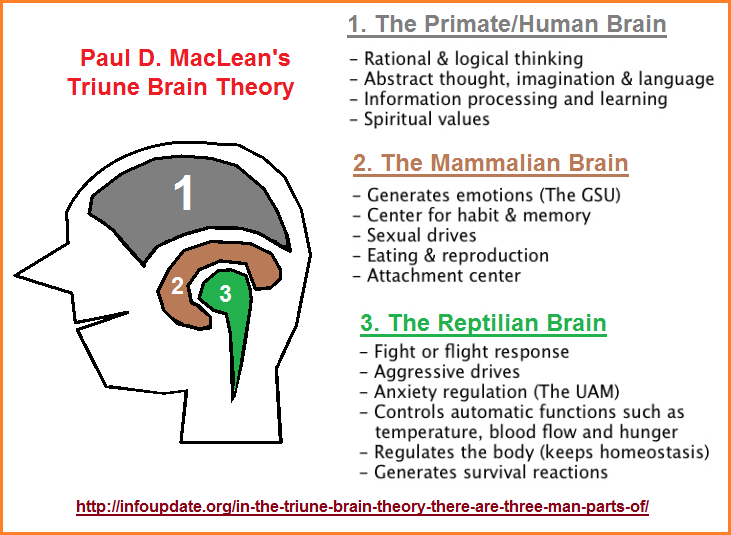
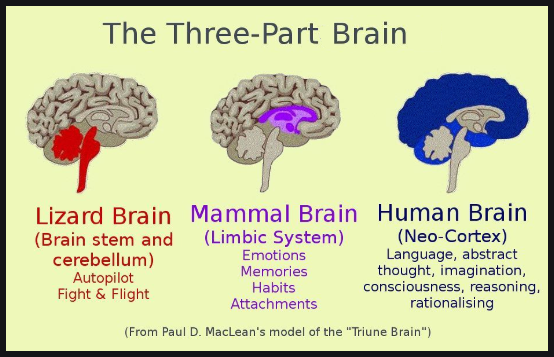
In looking at the brain, we might well generalize that there are phases one might enter into called Hypo-alertness, Alertness and Hyper-alertness. We can summarize these three as follows:
- Hypo-alertness (subconscious, instinctual, physiologically reflexive, background semi-consciousness described as the "unconscious thinking" involved in seemingly inactive assimilation of material for creativity, problem solving intimations, etc...)
- Alertness (everyday consciousness... whether this pertains to a cultures ignorance or insightfulness, wisdom or brutality, etc...)
- Hyper-alertness (genius, active creativity, etc...)
One might also refer to three states of the mind in terms of insanity, sanity, and super-sanity.
Yet, it is well known that there is brain activity involved in sleep patterns, to the effect we humans tend to align our interpretations with a pattern-of-three, typically with the formula of stage 1, stage 2, stage 3 and REM (Rapid Eye Movement). In this scenario with may also describe it as a 3-to-1 ratio. If the formula involves a description of wakefulness, then we have two references aside from the three stages. However, alternative interpretations can be found suggesting there is a 4-stage process to sleep followed by REM. Hence, with the addition of wakefulness, we have a categorization of six, which is a doubling of three. In any respect, we do not see a model exhibiting a high number value because brain activity does not typically portray the usage of high enumerated values. In other words, we do not observe routine brain activity using high values of enumeration.
For those who missed it, there is a return to the usage of stages one and two after stage three has been reached. This is reminiscent of someone taking two steps back in order to leap over a chasm, or the temporary indecision of an animal making a jump from one tree branch to another.
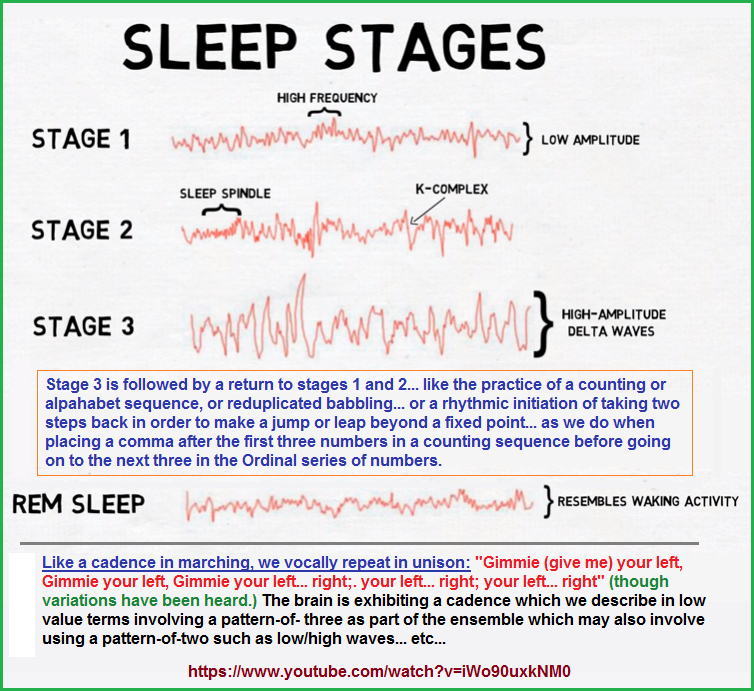
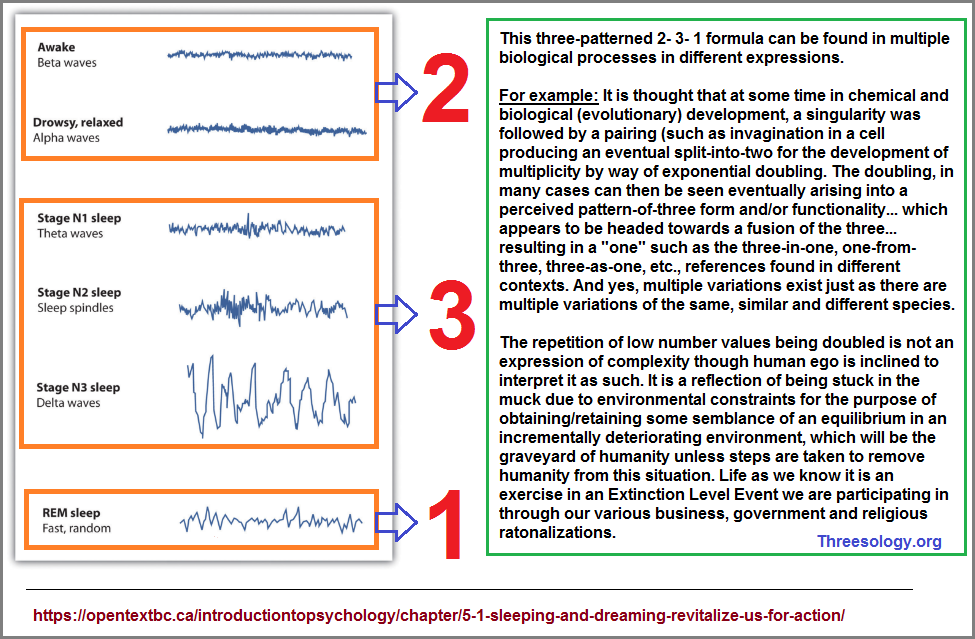
The Sleep and other brain activity involves brain waves as well as states of mind. In regards to states of mind we can find multiple references exhibiting the count of a described "4", but under closer examination we find that the fourth is considered separate from the other three by some labeled distinction. And it is rather curious that in the following example the representation describes "4" states of consciousness in relation to "OM" (AUM), but doesn't actually tell readers that OM references a "three-oriented" state of mind... nor that auditory forms of meditation revolve around an aural processing mechanism of hearing that involves an auditory process significantly designed with a "three" pattern as the following illustration reveals, and has been shown at this site numerous times:
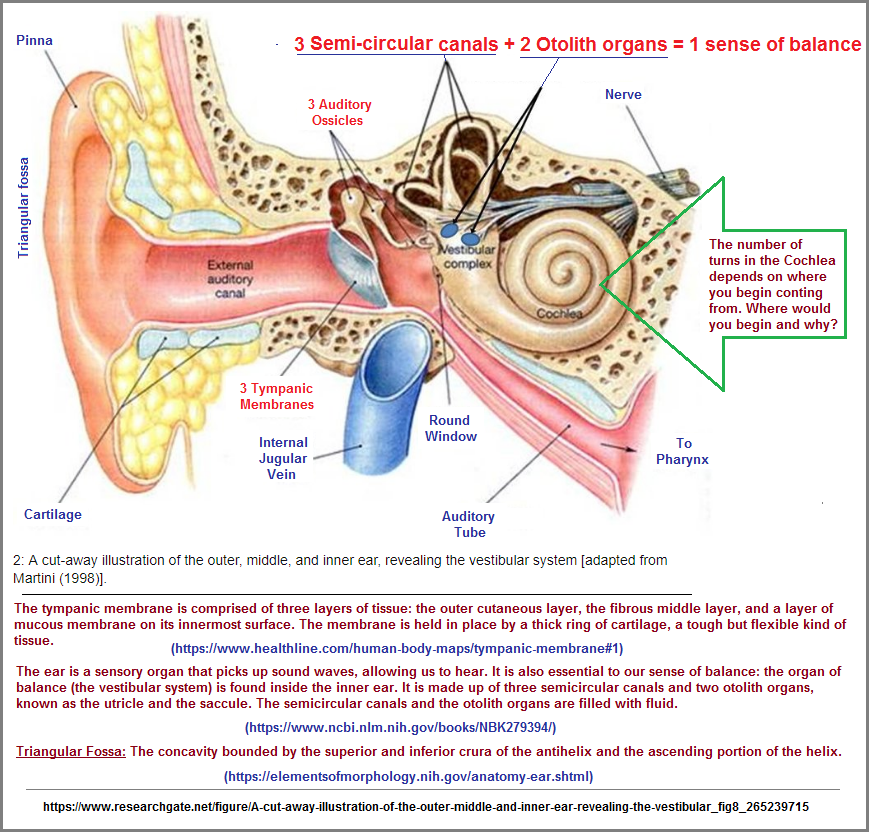
Language 3s page 1
In essence, a so-called 4th state of mind that is distinguished from and suggested as being unique from the three in an attempt to compliment itself as being something superior and without the need of an experienced humility that does not wallow in pride and self-importance, can alternatively be viewed as a 3-to-1 ratio:
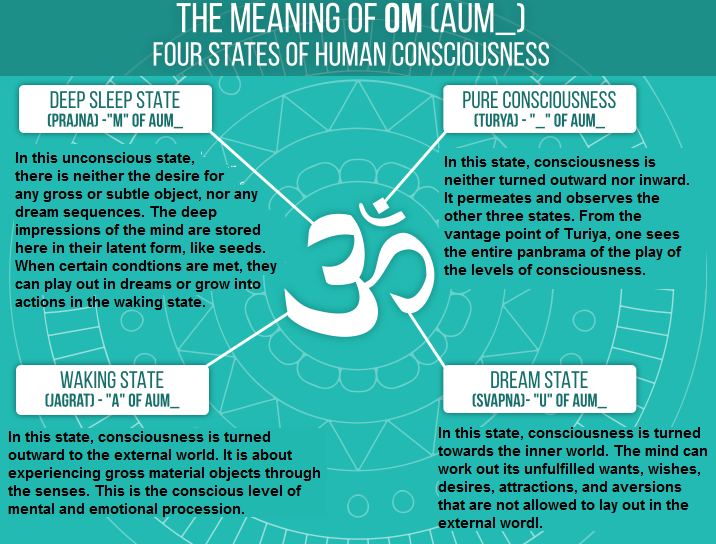
The descriptions of the first three states correspond very closely with how modern science describes our brain activity during those states:
Yet Mandukya Upanishad also talks about the fourth state of consciousness, which is different from the other three states. "The fourth aspect of Atman or Self is Turiya, literally the fourth. In this fourth state, consciousness is neither turned outward nor inward. Nor is it both outward and inward; it is beyond both cognition and the absence of cognition. This fourth state of Turiya cannot be experienced through the senses or known by comparison, deductive reasoning or inference; it is indescribable, incomprehensible, and unthinkable with the mind. This is Pure Consciousness itself. This is the real Self. It is within the cessation of all phenomena. It is serene, tranquil, filled with bliss, and is one without second. This is the real or true Self that is to be realized." This fourth state is usually called "pure consciousness" or "super-consciousness". It sounds remarkably similar to the meditative states with distinctive brain wave activity that the scientists had observed in long-term meditation practitioners. |
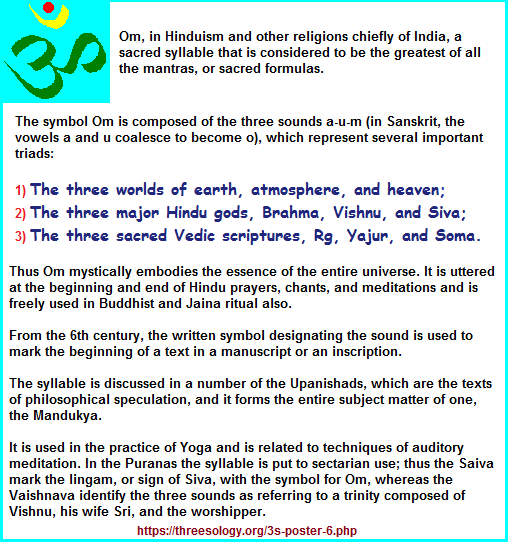
Here is a reference to an idea involving seven states of consciousness that, when looked at a bit more closely, reveal three-part compartmentalizations which reference a desire to return to a "ONE" consciousness. A state of mind no doubt similar to the thinking where the many multiple religious practices and religions and religious ideas were subjected to an effort to organize them into a unified whole by asserting the primacy of a single religion and single god.
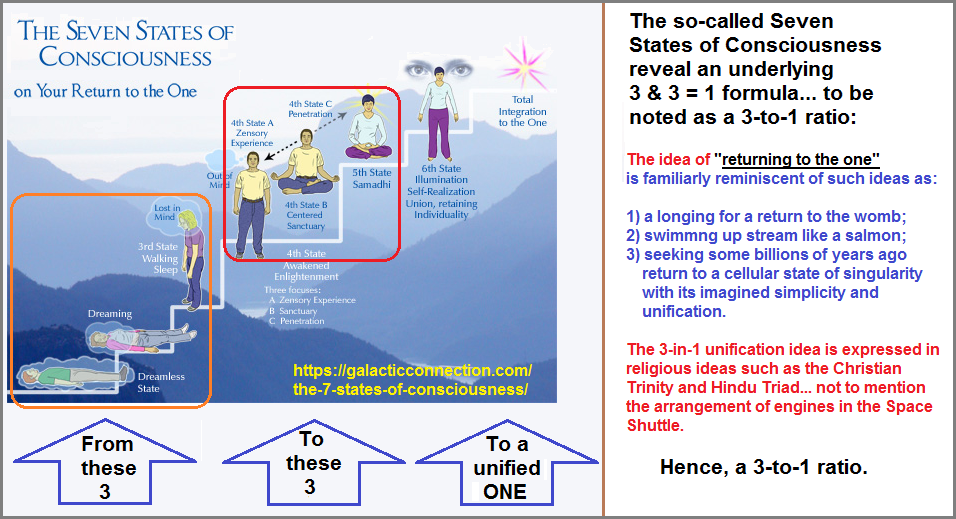
With respect to brain waves (which might be interpreted to be visually approximated representations of repeating Vs, W's or 3s)— here is but one example that the casual observer might well count as five (or six) types, but a bit closer view unveils the presence of a 2/3 or 1/1/3 ratio. (The ultra-low waves may be a type of vestigial organ/behavior... or phantom limb phenomena... or semi-vestigial and semi-phantom.) While alternative counting scenarios may be of interest to some viewers, the following will suffice for the present discussion:
| One Feature | Infra-Low (<.5hz) brainwaves (also known as slow cortical potentials), are thought to be the basic cortical rhythms that underlie our higher brain functions. very little is known about infra-low brainwaves. their slow nature make them difficult to detect and accurately measure, so few studies have been done. they appear to take a major role in brain timing and network function. | ||
| Two Features Delta Theta ↓ ↓ |
 |
DELTA WAVES (.5 TO 3 HZ) | Delta brainwaves are slow, loud brainwaves (low frequency and deeply penetrating, like a drum beat). They are generated in deepest meditation and dreamless sleep. Delta waves suspend external awareness and are the source of empathy. Healing and regeneration are stimulated in this state, and that is why deep restorative sleep is so essential to the healing process. |
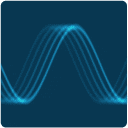 |
THETA WAVES (3 TO 8 HZ) | Theta brainwaves occur most often in sleep but are also dominant in deep meditation. Theta is our gateway to learning, memory, and intuition. In theta, our senses are withdrawn from the external world and focused on signals originating from within. It is that twilight state which we normally only experience fleetingly as we wake or drift off to sleep. In theta we are in a dream; vivid imagery, intuition and information beyond our normal conscious awareness. It’s where we hold our 'stuff', our fears, troubled history, and nightmares. |
|
| Three Features: Alpha Beta Gamma ↓ ↓ ↓ |
 |
ALPHA WAVES (8 TO 12 HZ) | Alpha brainwaves are dominant during quietly flowing thoughts, and in some meditative states. Alpha is ‘the power of now’, being here, in the present. Alpha is the resting state for the brain. Alpha waves aid overall mental coordination, calmness, alertness, mind/body integration and learning |
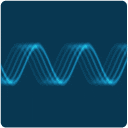 |
BETA WAVES (12 TO 38 HZ) | Beta brainwaves dominate our normal waking state of consciousness when attention is directed towards cognitive tasks and the outside world. Beta is a ‘fast’ activity, present when we are alert, attentive, engaged in problem solving, judgment, decision making, or focused mental activity. Beta brainwaves are further divided into three bands:
Continual high frequency processing is not a very efficient way to run the brain, as it takes a tremendous amount of energy. |
|
 |
GAMMA WAVES (38 TO 42 HZ) | Gamma brainwaves are the fastest of brain waves (high frequency, like a flute), and relate to simultaneous processing of information from different brain areas. Gamma brainwaves pass information rapidly and quietly. The most subtle of the brain wave frequencies, the mind has to be quiet to access gamma. Gamma was dismissed as 'spare brain noise' until researchers discovered it was highly active when in states of universal love, altruism, and the ‘higher virtues’. Gamma is also above the frequency of neuronal firing, so how it is generated remains a mystery. It is speculated that gamma rhythms modulate perception and consciousness, and that a greater presence of gamma relates to expanded consciousness and spiritual emergence. |
|
More basic then the three categories of brain waves is a reference to the three types of brain neurons:
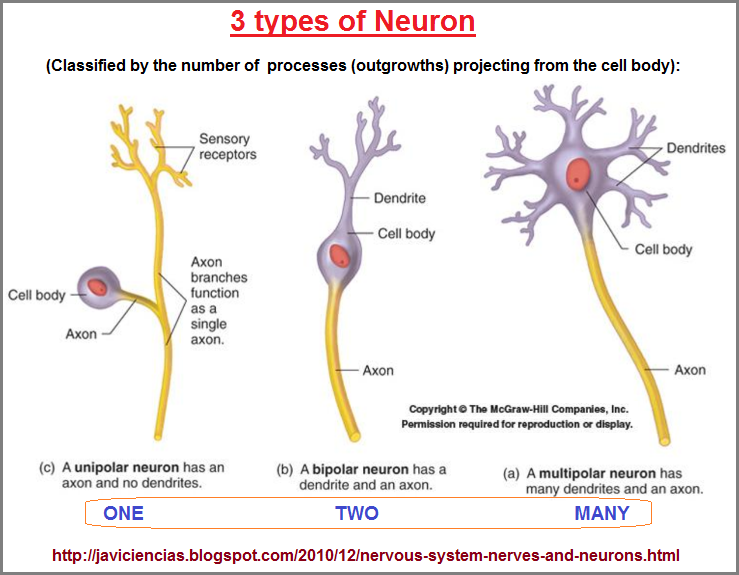
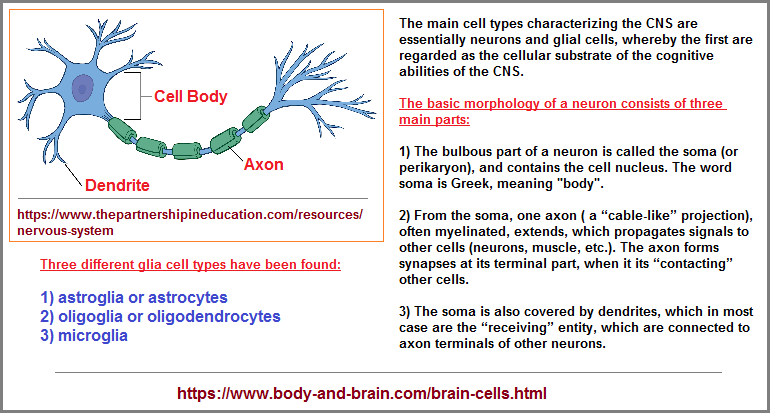
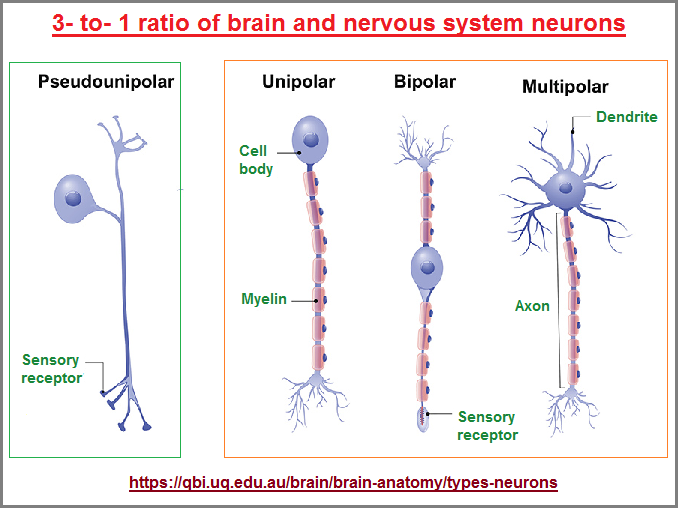
Some references to brain chemistry with a "three" orientation:
Three important brain signaling chemicals affect the way that we handle uncertainty:
- Noradrenaline regulates our estimates of how unstable the environment is.
- Acetylcholine helps us adapt to changing environments.
- Dopamine pushes us to act on our beliefs about uncertainty.
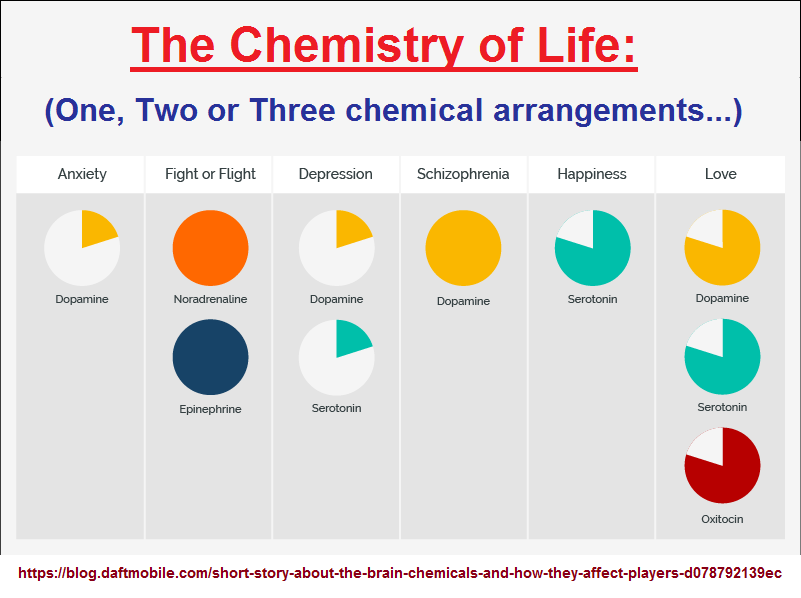
While the exact number is not known, there are well over 100 neurotransmitters. Here are the functions of three major ones:
- SEROTONIN: Serotonin is known as the "don’t worry, be happy”"soothing neurotransmitter.
- DOPAMINE: Often called the “motivation molecule,” dopamine provides the drive and focus you need to be productive.
- Gamma-aminobutyric acid (GABA): GABA is an amino acid that also functions as a neurotransmitter that is considered the brain’s main "calming" neurotransmitter. It is essential for brain metabolism and works to decrease neuronal activity and inhibit nerve cells from excess firing. Although GABA’s primary responsibility is to help regulate the activity of neurons, it is also very important for the maturation of new nerve cells (neurogenesis). In addition, GABA has mild relaxation properties and can enhance mood and support sleep.
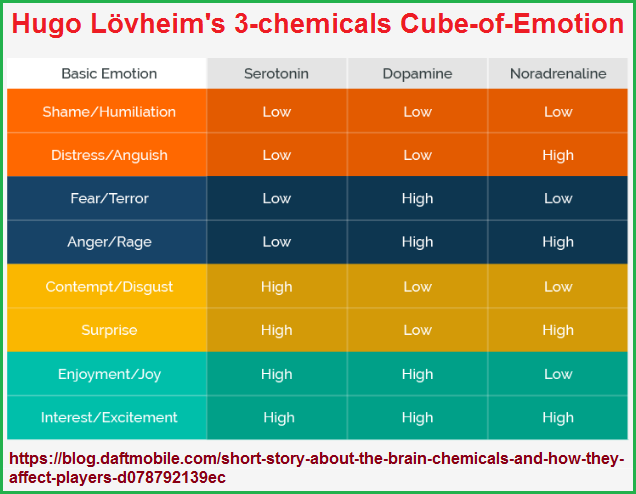
Serotonin and Noradrenaline strongly influence mental behavior patterns, while dopamine is involved in movement. These three substances are therefore fundamental to normal brain function.
Here is an image which not only references three brain chemicals but associates it with the value of 8 distinctions, which is a combination seen sometimes in physics discussions. It is provided for those who have made the respective correlation and catalog various examples thereof.
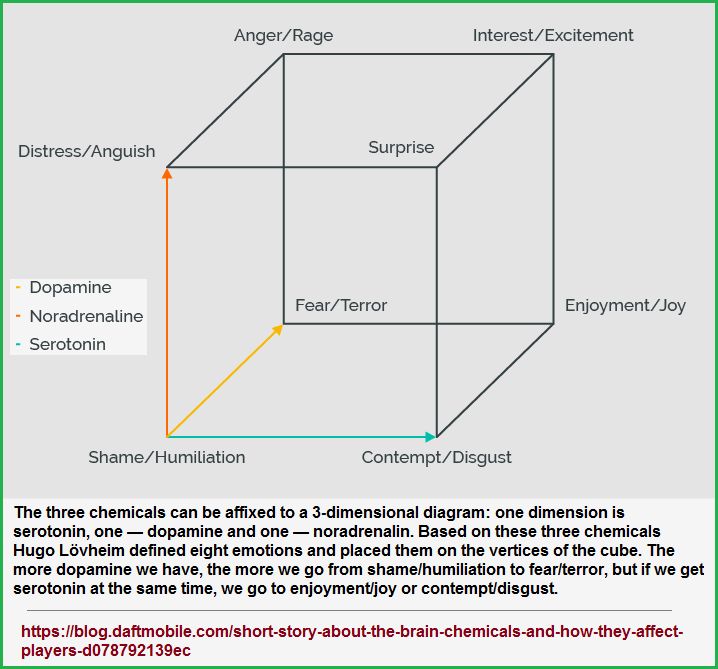
Origination date: Tuesday, September 11th, 2019... 1:05 PM
Initial Posting: Friday, September 13the, 2019... 3:03 PM
Updated Posting:Tuesday, January 17th, 2023... 12:29 AM
Herb O. Buckland
herbobuckland@hotmail.com